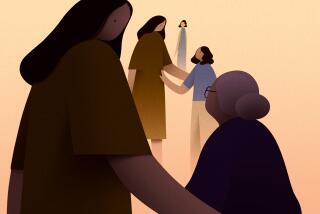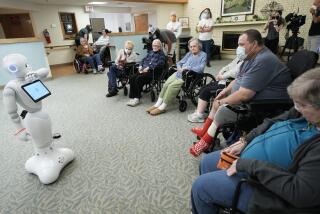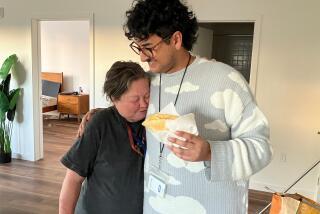Unseen, unsung
LISA WOOD describes herself as a woman in the middle -- a daughter and mother struggling to nurture one new life and, with equal tenderness, attend another on a fitful journey to its end.
At 44, she cares for a 5-year-old daughter and a once fiercely independent mother with early Alzheimer’s disease, who at times can be as demanding and exasperating as her child. The result, says the Sunland resident, is a life lived on a hamster wheel of constant motion and little progress.
“There are times when I’m so stressed I know [my blood pressure] has to be high,” says Wood. “I feel trapped sometimes; on the bad days I feel trapped.”
At some point in their lives, vast numbers of baby boomers and their children will become caregivers for ill and elderly relatives. Ten years ago, a study estimated that nearly 1 in 4 American workers provided informal care for an elderly or ill family member. Today, experts think that about 46 million American adults (or 1 in 6) do so and predict those numbers will surge in the coming decade, as a wave of baby boomers age, expected life spans grow and institutional care becomes more costly and uncertain.
Studies show that few will regret the time spent caring for an ill or dying relative, but new research suggests that many will pay dearly in terms of family income and their own mental and physical health.
The majority of those caregivers who are employed juggle paid work and elder-care, reducing hours on the job (and often pay, promotions and pensions) to do so. A 2003 study found that family members caring for those with dementia suffered suppressed levels of immunity for three years following their stint of caregiving, raising their risk of developing a chronic disease themselves. Other surveys have found that compared with the general population, caregivers -- especially those with intensive caregiving demands and those already in fair or poor health -- are less likely than their noncaregiving peers to attend to their own healthcare needs, less likely to exercise or see their doctor regularly and more likely to eat poorly and drink alcohol excessively.
For the 30% of caregivers who are elderly themselves, and hence more likely to be in frail health, the experience can actually be their undoing. A 1999 study published in the Journal of the American Medical Assn. found that when a spousal caregiver with a history of chronic disease was under stress due to caregiving, he or she was 63% more likely to die during the study period than a peer without such caregiver responsibilities.
And depression is nearly epidemic among this population -- more than half of family caregivers appear to suffer substantial depressive symptoms, says Kathleen Kelly, executive director of the Family Caregiving Alliance in San Francisco. In a recent survey of caregivers who identified themselves as being in fair or poor health at the outset of taking on duties, 91% suffered from clinical depression.
It is a reality underscored by Wood, who says she has struggled with the isolation, the never-ending needs and the growing irritability of her mother as Gwendolyn Grimes’ ability to function independently ebbs. Wood says that some days, she’s calm. But on many others, her moods swing between annoyance and anger about her predicament to guilt and sadness about her mother’s condition.
“I don’t always have the joy that I should,” she says. “I need to work on that.”
On occasion, Wood questions whether her family’s house is the best place for her highly social mother. But converting a cottage to house the 83-year-old was costly, and that cost has foreclosed the option of placing her in a facility with more structure and social interaction. Also foreclosed for Wood is the option of escaping to the rewards and distractions of a workplace away from home. Wood says she “had a bit of a career” going, but left her job in 2001 when her mother developed breast cancer and needed her help.
As her duties have mounted, Wood says, a few key things have gone by the boards. There’s a full night’s sleep, for one, and privacy for another. Also gone from Wood’s caregiving existence are the mountain hikes and visits to the gym that used to be part of her routine, and the medication that she is supposed to take to control her high cholesterol. And finally, there’s the loss of a mother’s help and guidance in the quotidian mysteries of parenting -- a promise that is fading like the memories in the ailing mind of Grimes.
“Sometimes I just want to be a daughter,” says Wood, her voice catching on tears. “There are things a woman has an idea about sharing with her mom when she has a child.... To have a second child when what you wanted most is your mom, it’s just hard.”
For caregivers, the unrelenting emotional and physical stress of tending to an ill or dying loved one appears to set off “a downward spiral” of health, says Richard Schulz, director of the University of Pittsburgh’s gerontology program and author of a landmark study of informal caregivers.
“It seems to begin with stress and chronic stress exposure, which probably contributes to depression; depression is linked to lots of chronic diseases, like diabetes, high blood pressure, heart disease and ultimately, death,” says Schulz. “Exacerbating this at every stage are two factors: that caregiving interferes with your care of self -- that you don’t see a doctor -- and that you don’t get enough rest.”
In the end, says Schulz, the act of caring for an ill relative appears to shorten the period of grief and depression that follows the death of the loved one. It is, in a psychological sense, “protective,” says Schulz. “It prepares you for the death [which] represents the end of suffering for both.”
But the negative physical effects of the caregiving may endure long after the grief of loss has lifted.
--
Under the radar
To state and local governments and the medical profession, informal caregivers such as Lisa Wood have long been invisible. They are the sons, daughters, spouses, siblings and friends who cook and run errands for the elderly infirm, ferry them to appointments and help them pay their bills and organize their medicines.
But as the nation ages and pressures grow on its system of institutionalized care for the elderly, this army of informal caregivers is beginning to emerge from the shadows. Government officials and physicians alike have begun debating how better to care for the caregivers of the ill and elderly.
In 2006, medical economist Peter Arno estimated that the cost of services provided “for free” by informal caregivers amounts to roughly $306 billion annually -- almost twice as much as is spent annually in the United States on paid home-care and nursing home services combined. If sons, daughters, spouses and siblings begin to bail on long-accepted obligations because of their personal toll, the nation’s healthcare system, and its already-stretched corps of geriatricians, will be swamped, experts say.
Caregiving has also become a central concern for employers. The MetLife Mature Market Institute, which tracks aging, retirement and elder-care issues for the Metropolitan Life Insurance Co., has estimated that near the turn of the 21st century, 3 out of 10 American workers have some responsibility for the care of a relative who is elderly or disabled. By next year, more than half of employees are expected to shoulder such an obligation. The missed days, early departures and on-the-job distractions of caregivers have been estimated to cost employers as much as $33.6 billion a year in lost productivity.
As this picture has emerged, the federal government has begun to step in, creating the National Family Caregiver Support Program in 2000. This year, the government will distribute $162 million to states to provide informal counseling, training and support groups, as well as respite care and, in some cases, equipment, technologies and home modifications that would help keep an elderly or disabled person in at-home care. But limited funds and the isolation of informal care providers have kept these programs from reaching anywhere near all those who could benefit from them: In California, 11 nonprofit Caregiver Resource Centers serve about 14,000 each year -- a tiny fraction of the estimated 3.2 million Californians who would likely qualify for help.
Kelly, the Family Caregiving Alliance director, says that growth in the field of caregiver support has been dramatic, spurred by politicians who have experienced the challenges of caregiving. But Kelly says that what’s striking still, “even [for] caregivers who’ve been in field and are very savvy about how the system works -- is how the system may not have worked for them. It’s an experience that’s very humbling.”
--
One-person hospice
For most caregivers, the caregiving experience is also very isolating.
Josie Garcia, a 43-year-old Silver Lake resident and film industry production assistant, shuttles daily to downtown Los Angeles to care for a mother immobilized by diabetes, dementia and, for the last three years, a broken hip, and a father now in the early stages of Alzheimer’s disease.
Four years ago, Garcia moved home from Florida to care for her parents, and she keeps up a frantic pace, working multiple jobs, sleeping in three-hour shifts, attending to the legal, financial and practical details of her parents’ care. She’d been at it virtually solo for two years when Garcia attended a meeting at her mother’s elder day-care facility and met, for the first time, others who lived as she did.
“That is when I first found out I was a caregiver. There was this whole new world that I didn’t know,” says Garcia. “I looked around the table and said, ‘Oh my God, you’re going through the same thing I am.’ ”
That 2005 meeting also marked the first time that Garcia discovered she qualified for a wide range of support services from the state. The help she gets from the state caregiver’s support program has given her an occasional break, kept her parents out of nursing homes and allowed her to remain sane as she juggles work and her parents’ declining conditions. Even with that help, caregiving’s physical toll on Garcia could outlast her daily obligations to her parents. Once an avid marathon runner, Garcia has stopped exercising altogether, has gained 30 pounds and eats and sleeps erratically. She’s developed sciatica from the added weight, a problem exacerbated by lifting her mom into bed and the shower.
But if caregivers such as Wood and Garcia are coming into sharper focus at the level of state governments, they remain nearly invisible to the medical community.
Physicians involved in the care of the elderly say powerful forces blind doctors to the plight of caregivers whose suffering is often right in front of them. First among them is the way that physicians are paid. “The way medical care reimburses physicians is based very much on an old-fashioned notion of a single disease, a medical treatment and the patient and physician in an isolated relationship” says Dr. C. Bree Johnston, a geriatrician and medical professor at UC San Francisco. “And the reality of caring for patients with chronic illness -- and particularly dementia -- is that we need a medical system that recognizes as valuable the care of the whole family as a unit.”
Though physicians’ groups such as the American College of Physicians have called for new attention to the role and needs of informal caregivers, Johnston says, “we certainly aren’t there yet.”
But the studies are. In a study published in the November 2006 Annals of Internal Medicine, a team of researchers led by Schulz tested whether a six-month “intervention,” consisting of 12 in-home visits and telephone sessions, would ease the stress -- and hence, potentially, the health effects -- of family members caring for dementia patients. The Schulz team found that across ethnic lines, it did, nearly cutting the rate of depression among caregivers in half and improving the caregivers’ self-care and perceptions of burden and social support. Other studies have found that caregiver support programs improved the quality of life for the patients they cared for and reduced healthcare costs by delaying those patients’ entry into nursing homes and critical care units.
In an accompanying editorial, Johnston and fellow UCSF gerontologist Dr. Kenneth E. Covinsky said those studies should be a rallying call for physicians, health insurers and state administrators of programs for the elderly and disabled to care better for the caregivers.
“Caregivers routinely risk their financial, emotional and physical well-being to provide care to their relatives or members of their community with dementia,” wrote Johnston and Covinsky. “It is time for the public to recognize their part of the social contract.”
--
Help and a sliver of hope
Wood says that even a little help from the California Caregiver Support Program has lifted her hopes and eased the burden of caring for her mother. For now, Wood says, she will give herself a break by placing her mother in some adult day care, and perhaps take advantage of some respite care down the road. She’s also begun to see a psychotherapist.
Both moves have helped improve her outlook, Wood says. She worries about the long-term toll that caregiving will have on her mental and physical health and on her family’s well-being. But for the time they still have together, Wood’s 5-year-old daughter, Isabella, can share her breakfast daily with a grandmother who adores her and hear a few last stories before her grandmother is gone forever. And Wood can give her mother the care and comfort she is sure Grimes deserves as this vibrant woman’s memory fades and her dependence becomes complete.
“I have a pretty clear perspective on what’s to come, and it doesn’t take the pain away, by any means,” says Wood. “But I’m on the right road ... at least I have some direction.”
--







